The best studio headphones are the best for every task from mixing and recording to tracking and critical listening. While you may be on the hunt for a set of cans for a specific purpose, you’ll undoubtedly use them across the board. That’s why we’re going to have a quick look at some things you should consider and then we’ll jump straight into the reviews by budget and class.
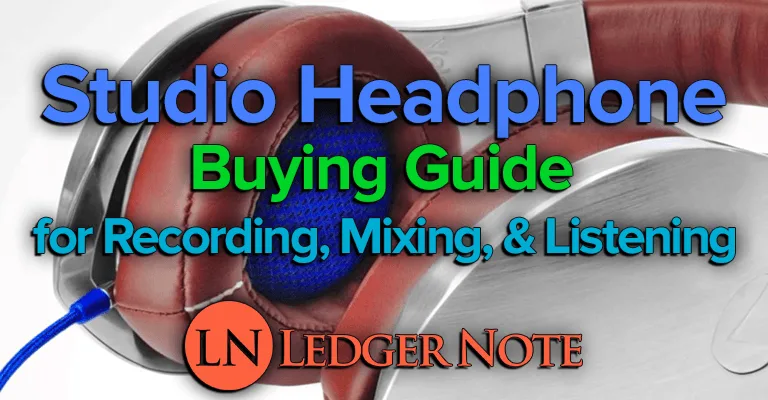
I don’t know if you’d call it fortunate or not but I’ve had the pleasure of using lots of different options including the best studio headphones on the market. I have used them in a million environments for a billion reasons, so I’ve got a few things to point out if you are thinking about committing to any one pair of headphones. One set can fit all of your needs as long as you think ahead.
The issue isn’t just audio quality, faithful sound reproduction, or which look the coolest. Of course those factors matter but what about the ability to buy replacement parts after you accidentally vacuum up the connector and cord? What about how comfortable they remain after you wear them for five hours straight?
If you already know the deal dive into our review of the best headphones for studio recording!
However, if you still are unsure, have questions such as “Which are the best headphones for recording? How about mixing?” Do read our guide as it will cover all of this and explain how those questions don’t make as much sense as you’d think.
Click here to visit our FAQs section!
The Best Studio Headphones
Included in this guide:
| Sony MDR7506 | Best Entry Level Headphones | Buy on Amazon |
| SENNHEISER HD 280PRO | Best Budget Pick | Buy on Amazon |
| Audio Technica ATH-M40X | Best for Casual Listening and Pro Monitoring | Buy on Amazon |
| Direct Sound EX-29 | Best for Noise Cancellation | Buy on Amazon |
| BEYERDYNAMIC DT770 PRO | The Best All-Round | Buy on Amazon |
| Shure SRH-1540 | Best of the Best | Buy on Amazon |
| Samson SR850 | Budget Open back | Buy on Amazon |
| AKG K 701 | Best Open Back | Buy on Amazon |
Sony MDR7506
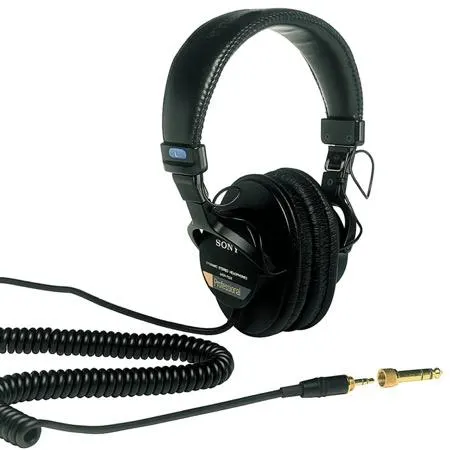
The Sony MDR7506 is the least expensive of the bunch and also the least “wow-inducing.” However, don’t take that to mean they aren’t lightyears beyond consumer cans because they definitely are.
I recommend these to anyone absolutely strapped for cash looking to enter the pro market for headphones. They also make nice ones to get banged up by a band if you need a dozen or so.
Otherwise, if you can save up just a little bit more, it’s worth looking at the next two options, including my all time favorite.
The MDR7506’s are sturdy and comfy. They have most of the features you’ll find in the more costly models, such as coiled cords just under 10 feet and an adaptors to switch from 1/8th inch to 1/4th inch for popping them into your smart phone on the go to enjoy some tunes.
They can blast 106 dB through the 40 millimeter drivers. That’s more than enough for circumaural closed backs. At only 8.1 ounces you can wear them all day, too.
Other electronics companies have also tried to jump into the headphone market with absurdly cheap prices for visually attractive headphones that sound like crap. Don’t waste your time. This is the bottom rung of the “pro ladder.” It’s a good rung, too.
Specs:
- Type: Over Ear
- Frequency response: 10 Hz – 20,000 Hz
- Connection: Wired
- Impedance: 63-ohm
Pros:
- Great sound
- Established brand and model
Cons:
- Bulky feel
SENNHEISER HD 280PRO
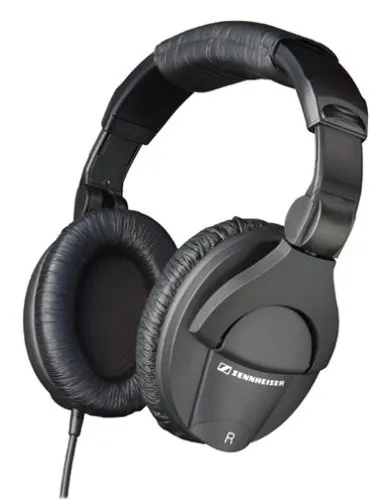
Whenever I’m asked about good headphones, the Sennheiser HD 280 Pro is always the first one out of my mouth. This is where I landed after trying tons of other brands of varying prices. The cost is more than competitive for the quality. Not just audio quality but build strength as well.
The ear cups not only swivel 90 degrees but fold up into the band as well, which keeps them safe and compact when traveling. I’m on my third pair, not because they ever broke, but because my old cat (bless her heart) puked right into the ear cup and ruined one.
I gave a set to a friend when he moved out in college, and now I have my third. What’s nice though is every single piece can be replaced as long as you don’t destroy the drivers (like that time I vacuumed the cord and adaptors).
These guys weigh 16 ounces, which seems like a lot but it’s because they are tanks. You’ll never notice the weight thanks to the foamy cushions that mold perfectly around your ears. You’ve got your adaptors, long cord, replaceable parts, and then the two best parts:
- They reduce all outside noise by 32 dB
- Their frequency response covers the entire human spectrum
From 8 Hz all the way up to 25 kHz, you’ll hear it all with minimal distraction thanks to the isolation and outside attenuation. Quality is such a subjective thing, but I can tell you that these bad boys stand up to even the amplifier powered ones at three and four times the price. Unlike many others, you have some serious clarity and imaging in the bass region.
Once I tried these I never bothered to try any other brand again. It’s top quality at relatively low price. Give them a try!
Specs:
- Type: Over Ear
- Frequency response: 8Hz – 25,000 Hz
- Connection: Wired
- Impedance: 64-ohm
Pros:
- Folding and rotating earcups
- Clear sound
- High ambient noise attenuation
Cons:
- Heavier than other models
Audio Technica ATH-M40X
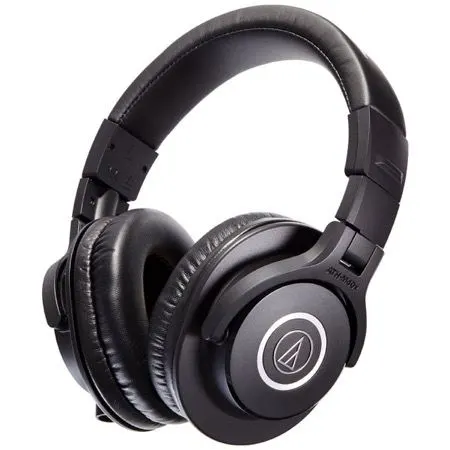
As an alternative to the HD 280 Pro’s above, I also quite enjoyed the Audio Technica ATH-M40x as well. I happened to enjoy the head band padding more on the others, but besides that they are almost the same thing.
They feature the same “tank” philosophy and the ability to swivel and fold up. Amazon even has a hard shell case they can fold up into on the cheap too, although they do come with a cloth pouch case.
Since I’m comparing these with the Sennheiser’s, what I did like about these were they were lighter at around 9 ounces and the cable could be detached. The detachable cable is cool because it keeps the jack from getting tore up in the pouch. Others will hide and protect that “joint” by building it into the ear piece. It’s not better or worse, just cool and different.
This means the cable is replaceable if lost, and you can also score replacement ear cups if they get raggedy after years of use. These get the job done in terms of quality too and make a perfect additional reference point in addition too your monitors.
If you don’t have monitors and acoustic treatment you can certainly do all you need on these or the others on this list. But get some monitors eventually too!
I liked these and had no qualms about them. They are a perfect alternative to my favorites. You may like them better.
Specs:
- Type: Over Ear
- Frequency response: 25,000 Hz
- Connection: Wired
- Impedance: 64-ohm
Pros:
- Folding and rotating earcups
- Clear sound
- High ambient noise attenuation
Cons:
- Heavier than other models
Direct Sound EX-29
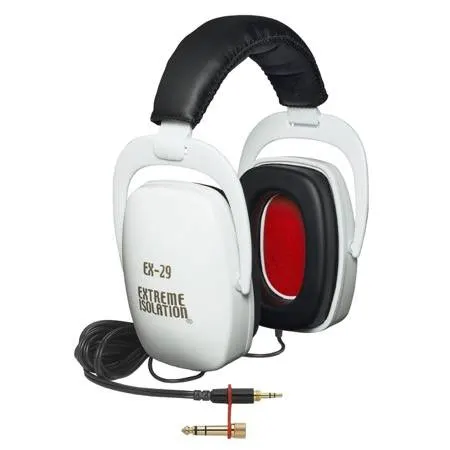
Extreme isolation is the name of the game with the Direct Sound EX-29’s. If you read reviews of any popular item you’ll see some knuckleheads who thought they could put these on and play the drums and they should block out the drums like ear plugs. That’s not the point!
The EX-29 boasts 29 dB of isolation (probably better than that, honestly), and that’s mainly to keep your backing track from bleeding into the microphones. These definitely do that very well. They also come in black or white color options which is cool. Everyone else typically only offers black. Why is that?
My experience can be summed up like this… They’re heavy and tight which is neither a pro or a con. They don’t fall off. Their frequency response doesn’t reach beyond 20 kHz which is fine for adults but young people may notice a lack of sparkle.
Other than that they were pretty comparable quality-wise. Just treat them kindly because the plastic is kind of thin on the head band and on the ear piece connectors. It’s not a problem if they stay at your desk or in the studio.
I approve of these and can say, “If they appeal to you, go for it!”
Specs:
- Type: Over Ear, Dynamic closed
- Frequency response: 20 Hz – 20,000 Hz
- Connection: Wired
- Impedance: 32-ohm
Pros:
- User-friendly repairability and universal padded
- Foldable for mobility and storage
- Best-in-class noise cancelling
Cons:
- Made of plastic
BEYERDYNAMIC DT770 PRO
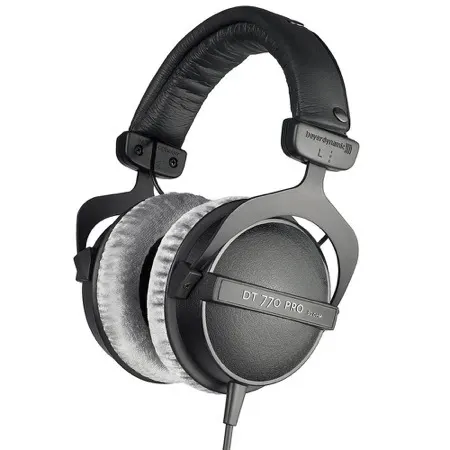
All in all, the build on the Beyerdynamic DT770 Pro’s are a bit nicer, especially with the padding and the cloth around the padding. The trade off is the plastic holding the ear pieces on.
You’ll want to take extra care not to stress them in any weird way when traveling as they aren’t as rugged as the others above. If they’ll stay in the studio or at the desk then there’s no worries. There’s a 2 year warranty anyways.
What I liked about these, besides the extra comfortable velour ear pads, was the incredible bass response. It wasn’t exaggerated like consumer sets. It was more accurate, even without an amplifier. I never tried them like that but I suspect it only gets better.
The only reason I never bought some of these for myself was the price. It’s not that much higher than the others but I was broke as a joke at the time. I feel it’s worth the ticket price, especially if you’ll be mixing and not just recording.
These babies are light and as comfy as it gets. The frequency response goes well above and below human capabilities so consider snagging a 2nd pair for your dog. Every part is replaceable and there’s even a travel bag. This is one of those lifetime purchases that’s totally worth it if you can spring for it at the time.
Specs:
- Type: Over Ear
- Frequency response: 5 Hz – 35,000 Hz
- Connection: Wired
- Impedance: up to 250-ohm
Pros:
- Great sound
- Best-in-class isolation
- Versatile and reliable
Cons:
- Quite bulky
- Not easily portable
Shure SRH-1540
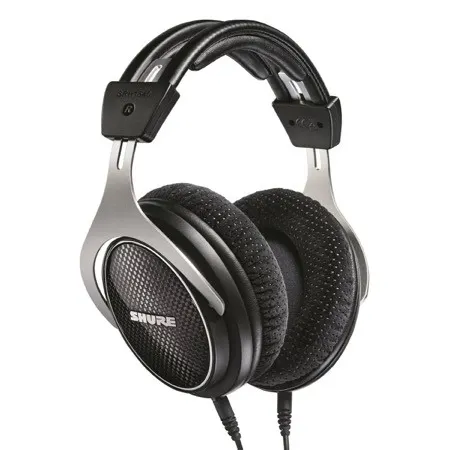
This is the big leagues. The Shure SRH 1540’s may appear on the surface like any other on the list but it’s just not the case. That’s not typical plastic you’re looking at but airplane-grade aluminum alloy. Solid.
They aren’t heavy either. I appreciated the cord being 6 feet instead of 9 too as a mixer at the desk. All that length can get annoying at times.
Admittedly I only used these here and there for a few days and didn’t push them through an amplifier. You’re going to want to do that with these to get the maximum quality out of them. Even so I could tell these were a cut above.
All pro headphones manage to get the mids and highs right. The challenge is producing a worthy bass signal out of small woofers. An amp helps but I could tell these shined in that area even without.
That’s about all I can say. If you want top of the line, this is it. Click the pic and read the reviews from the pro’s there. It’s unanimous besides the one person who claimed they sounded like $20 headphones (okay, bro). Everything sounds like that when you listen to a 128 kbps MP3 on your Zune.
If you score some of these, send me a pair! I may spring for these when my HD 280 Pro’s die.
Specs:
- Type: Over Ear, closeback
- Frequency response: 5 Hz – 25,000 Hz
- Connection: Wired
- Impedance: 46-ohm
Pros:
- Great for monitoring
- Expansive soundstage
- Sleek lightweight design
Cons:
- Need a good amp for bass
Samson SR850
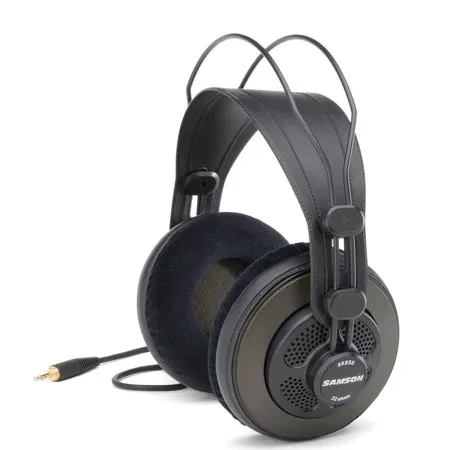
The Samson SR850′s represent the super affordable spectrum of the open back realm. Which makes me surprised at how nice and comfortable they are. Not that they shouldn’t be but a lot of companies will skimp out on their lower-end offerings. This is a testament to the care Samson puts in all of their products.
I had a pair of these a long time ago and remember being amazed by them as my first step up from in-ear sports earphones. They are pretty good relatively, especially for the price, but don’t expect a miracle. These can make a great introduction into the world of better cans.
These are the kind you use till they croak then you toss them. You won’t find replacement parts available. What you’ll discover is that these don’t reach down into the deep bass but the open back allows for some nice punch in the upper bass with the kick drums.
Otherwise they do pretty well in the mids and highs. It’s the cheap option and you can get by with them but if you’re trying to do very serious work, look at the next choice below.
Specs:
- Type: Circumaural, semi-open
- Frequency response: 20 Hz – 20,000 Hz
- Connection: Wired
- Impedance: 32-ohm
Pros:
- Armored av
- Inexpensive yet quality choice
Cons:
- Professionals will consider these too low quality
AKG K 701
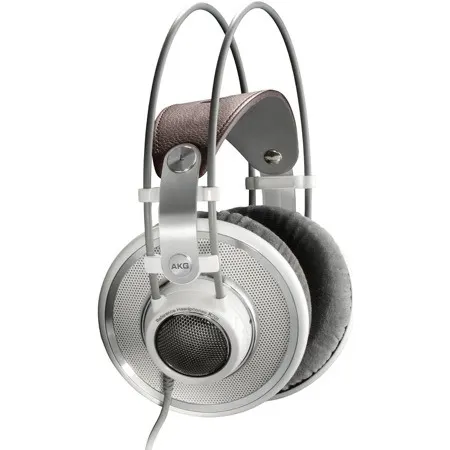
I’d call the AKG K 701 headphones mid-range in terms of pricing. I don’t mention any higher priced open backs here for two reasons: I haven’t tried them and that’s because if you spend more than this you should be getting a closed back set of cans so they are multipurpose.
I think these are some seriously handsome headphones. The band is leather and keeps the actual support structure off of your head as you can see. The ear cups are fairly large too, which provides solid comfort for long sessions, particularly for us big-ear folk.
These boast some unique technology in the diaphragms and coils in the driver that supposedly offer better quality. I was skeptical of these kind of claims until I tried Adam’s ribbon tweeters on my monitors. It can be true, which seems to be the case with these.
With these you’re going to want to use a headphone amplifier of some sort even if it’s a desktop DAC. You need the juice to get enough volume out of them if you like to listen loud. They don’t even come with the 1/8th inch adaptor. That’s the hint.
My opinion is that these can work more than well for a set of dedicated mixing headphones, but remember that the open back will leak sound some. It’s not that bad but it can have backing tracks leaking into your mic recordings or can tick off the guy in the next cubicle if you take them to work.
Specs:
- Type: over-ear, open
- Frequency response: 10 Hz – 38,900 Hz
- Connection: Wired
- Impedance: 63-ohm
Pros:
- Lightweight
- Very comfortable
Cons:
- Plastic gives a cheap feeling
- Open-back means non-existent noise cancelling
FAQs
Consumer vs. Professional Headphones
The first thing to understand is the difference between consumer headphones and those for music industry professionals. A set of Sennheiser’s may cost the same as Beats By Dre, but one justifies the price through research and development and the other just has to cover the insane marketing budget. I’m sure you can guess which is which.
So what’s going into this research and development that makes pro cans better than consumer ones?
Frequency Response
The goal of studio earphones, even the in-ear buds, is to provide a flat frequency response. This means that it adds no flavor to the sound. You need to hear what you’re working on as neutral and true as possible, especially when mixing. This costs money to develop cones to that level of precision.

Consumer headphones don’t care about this at all. As a matter of fact they purposefully mess it up in order to satiate a certain demographic. Beats By Dre are designed for Rap, Pop, and R&B listeners which explains the outrageous bass response.
Most of these types employ what’s called a “Smile Curve” in the frequency response. It boosts the bass and the high-end and leaves the middle lacking because a lot of people find this pleasing, particularly in noisy environments like the gym or school bus.
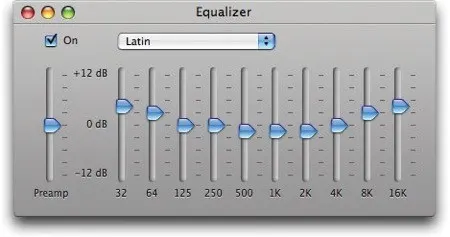
You can imagine that it’d be hard to call any critical listening shots with that equalization curve. It also literally ruins the mixes and recordings other pro’s worked hard to achieve. You’ve not heard your favorite records correctly until you do it with some real nice recording headphones!
Now let me say that most of the time you’ll see a slight bass boost in the frequency response curves of pro-phones too. This is because woofers this small can’t produce deep bass without that help.
It looks “off” on paper but to your ear it will sound completely flat and neutral. It’s compensation for the lack of bass in this case and intentional. Don’t be alarmed is my point.
Small Considerations Before a Purchase
Let’s knock these out before we get to the most important aspect of all.
- What’s Your Budget? As mentioned above, pricing doesn’t equal higher quality. I’ll cover you here with my recommendations below (and save you a ton of cash). Achieving higher quality and flatter frequency responses is a diminishing returns type of thing. You pay increasingly growing increments for smaller gains in quality.
- What’s The Purpose? Again, I’m going to drop some insight on the next section to help you think about this. But you need to be realistic. Are you only recording? Will you be mixing too? Will you listen for pleasure as well? Most of us buy one pair of headphones to cover all uses.
- Will You Need an Amplifier? Some headphones require headphone amplifiers to drive each woofer. If you’re buying say… 10 pairs for an entire band to wear while recording you’ll want an amp for independent volume control and routing sub-mixes anyways. Most of the ones I’ll show you don’t need an amp so you can plug it right into your iPod or whatever and keep them portable.
Also think about the padding of the ear cushions and head band for comfort. Consider as well, especially in the higher range, if replacement parts are available. Okay, now we get to the big question and my advice surrounding it.
Closed Back or Open Back?
The big question that changes everything. When it comes to headphones there are two classes available: closed or open backs. Let me go ahead and say it so you can think about it as you read along.
I prefer closed back headphones in all cases.
You’ll understand why in a second.
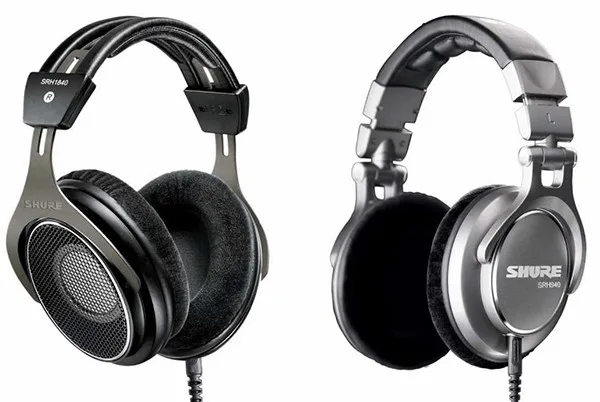
Open on the left, closed on the right, I write headphone rhymes every time that I type.
The difference is that some headphones feature a grill on the outside/backside of the woofers that lets air and sound escape. It also lets sound in. Closed back headphones don’t let sound in or out.
Let’s look at this from my viewpoint of closed being superior for studio work like recording, tracking, and mixing.
Pros of Closed Back:
- When listening, no unwanted sounds get in. This let’s you focus and hear minute details and changes.
- When recording, no sounds leak out and back into the microphone. This also provides privacy and keeps you from annoying everyone else around you at work or wherever.
Cons of Closed Back:
- Sound pressure can’t escape (so keep the volume at a reasonable level).
People do claim there is this one downside to closed back headphones. Like if you’re riding your bike you may not hear cars coming like you would if their engine sounds and the wind could contaminate your listening experience. This is really stupid logic in this context and worlds of others.
The only real objection is that closed back headphones don’t let sound pressure escape so you might end up with a cavity resonance or damaged hearing. This is partially a legitimate reason except you shouldn’t be listening loud enough for it to ever matter.
You should only be spot checking loudly here and there. The closed nature blocks out everything else when they are circumaural (over and around the ears). There’s no need for it and it can harm your hearing.
Check out this table. You’re going to wear these a lot for long exposure times. Open back headphones will encourage you to turn up the volume if other sounds are going on around you.
| SPL | Time |
|---|---|
| 85 dB | 8 hours |
| 88 dB | 4 hours |
| 94 dB | 1 hour |
| 97 dB | 30 minutes |
| 100 dB | 15 minutes |
| 112 dB | < 1 Minute |
| 115 dB | < 30 seconds |
You can see that I skipped some Sound Pressure Level (SPL) increments but it still illustrates the point. Every teeny tiny boost in volume cuts the time in half before you begin to damage your hearing. Your kids aren’t ignoring you, they’re just deaf already.
I see no benefit to open backs unless you just like the way they look. They render headphones useless unless you’re in isolation from all other human beings and sounds. You can’t record with a microphone with them either.
These are the Best Studio Headphones
I rest my case! The entire point of professional headphones isn’t to have thumping bass or look cool at the gym. It’s all about hearing the most true, non-colored, least exaggerated version of whatever you’re listening to as possible that even the best studio monitors can’t deliver without blowing a fortune on acoustic treatment.
This is so you can study, listen critically, and make precise tweaks and changes to your mixes and recordings. Some people like open back cans for pleasure listening but for getting lots of various types of work done with one set, I vote closed back as the best studio headphones.